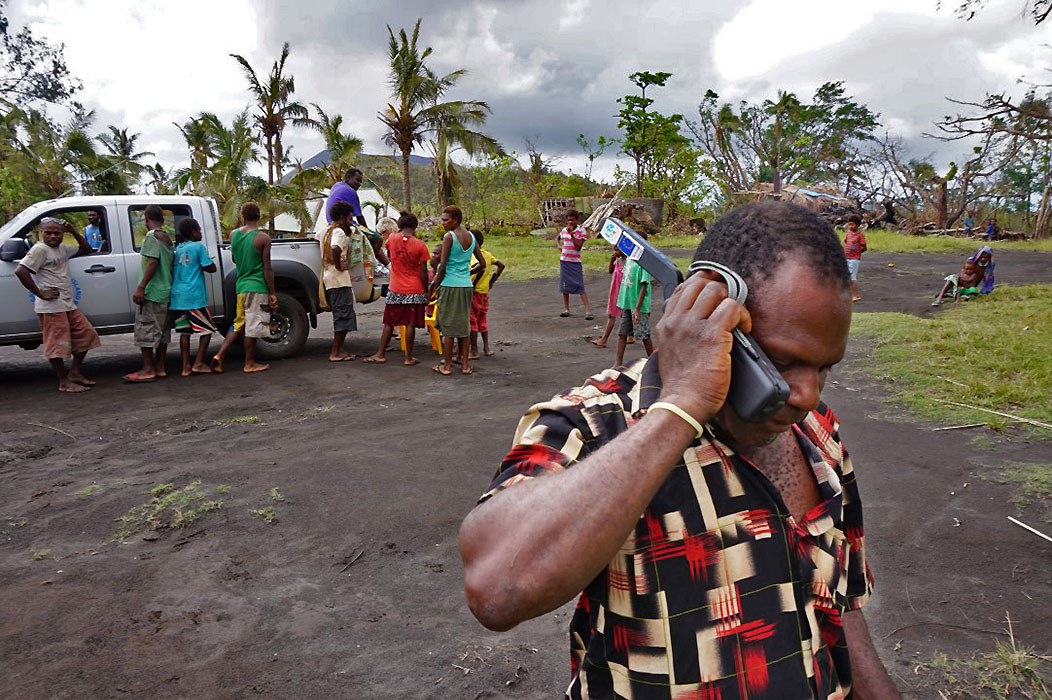Cyclone Pam
Context: Cyclone
Start date: 14/03/2015
End date: 07/05/2015
Areas of intervention:
- Torba
- Penama
- Sanma
- Malampa
- Shefa
- Taféa
Activities:
- Telecoms assessments
- UNDAC support
- Support to coordination
- Humanitarian calling operations
- Capacity building
Reinforcing national coordination
15,476 MB of data transferred
5,572 calling minutes
Communication for populations
4,860 beneficiaries
5,134 calling minutes
63 communities reached
Context
Cyclone Pam (category V) entered into Vanuatu territory on 12th March 2015. With sustained wind speeds reaching up to 250 kmh, vast areas of the country were heavily damaged and the telecommunications network down on the majority of the country’s 65 inhabited islands. Cyclone Pam claimed the lives of 16 people and affected over 166,000.
Each of the archipelago’s six provinces was affected by the cyclone, and whilst Vanuatu’s MNOs worked to restore the terrestrial network, the lack of communication between the provinces severely hindered coordination and aid conveyance between the various islands that had been isolated from one another.
Aware of the threat that Cyclone Pam posed, Télécoms Sans Frontières positioned its teams in Brisbane (Australia), allowing them to deploy in the directed aftermath. TSF arrived in the capital of Vanuatu, Port-Vila, on 16th March alongside teams from the United Nations Disaster Assessment and Coordination body.
The following operations were carried out thanks to the support of the European Civil Protection and Humanitarian Aid Operations (ECHO).
Support to coordination
Supporting government response
Working in direct collaboration with the Office of the Government Chief Information Officer (OGCIO), TSF installed an internet network at the heart of the capital, using a Wi-Fi bridge to link up the National Disaster Management Office (NDMO) to the NGO Coordination Centre where the majority of UN and international organisation were based. These strategic locations connected by TSF were the central point for information consolidation from the country’s six provinces, and also hosted national crisis cells and coordination meetings. TSF’s connectivity brought together the essential elements that allowed Vanuatu’s provinces to receive aid actively and efficiently.
In collaboration with the Emergency Telecommunications Cluster (ETC), TSF attributed satellite lines to each province of Vanuatu, allowing the provincial disaster management offices to escalate aid requests to the national bureau in Port-Vila.
On the ground in each province, TSF’s teams installed a mobile satellite internet connection in each operations centres. Without these connections and satellite lines, the only means to communicate needs to the capital was to go there, however the distance, the lack of air transport and the danger of crossing the rough seas meant that the majority of islands were isolated from one another. The Director of the National Disaster Management Office was provided with a dedicated satellite line to ensure he had the means to efficiently manage national response and contact each of the 6 provinces for which he was responsible.
10,511 MB of data was transferred between the islands, as well as over 5,300 minutes of calls to help bring aid to Vanuatu’s weakened provinces.
Support to NGOs
In addition to its support to the national response mechanism, as partner of UNDAC, TSF supplied connectivity to the UN Reception and Departure Centre at Bauerfield Airport, Port-Vila, to assist in facilitating the registration of the international humanitarian actors arriving in the country.
Faced with nationwide coordination matters, TSF committed to supporting the international NGOs already present in Vanuatu, notably on the islands of Tanna and Erromango (Taféa province). Teams provided satellite internet to the offices of the French Red Cross in Tanna and Care International in Erromango, ensuring that the connections were open to the benefit of all humanitarian workers of the region.
4,965 MB of data were used for coordination on the islands of Tanna and Erromango.
Humanitarian calling operations
Assessments revealed that the islands of Tanna and Erromango, as well as the north of Efaté had been particularly affected by Cyclone Pam, leaving populations without contact with their families who worked in the capital, on other islands or indeed abroad. Indeed, many of the country’s younger generations leave their natal island to work in Port-Vila or study abroad. Following the cyclone, they had not managed to get in touch with their families.
TSF covered 63 communities to provide priority calls to 876 families, with over 5,000 minutes to the capital, New Zealand, New Caledonia and other Pacific Islands.
Capacity building
Situated on the Pacific Ring of Fire, as well as on the trajectory of several cyclones, Vanuatu is particularly exposed to high-risk disasters. In order to provide the government with an immediate response capacity, TSF provided 6 emergency telecoms kits (one for each province), as well as training in their use with the OGCIO.
Each kit contains satellite internet equipment, satellite lines, modems, and any other necessary peripheral apparatus to ensure that the government remains connected in the event of a terrestrial communications outage.
























